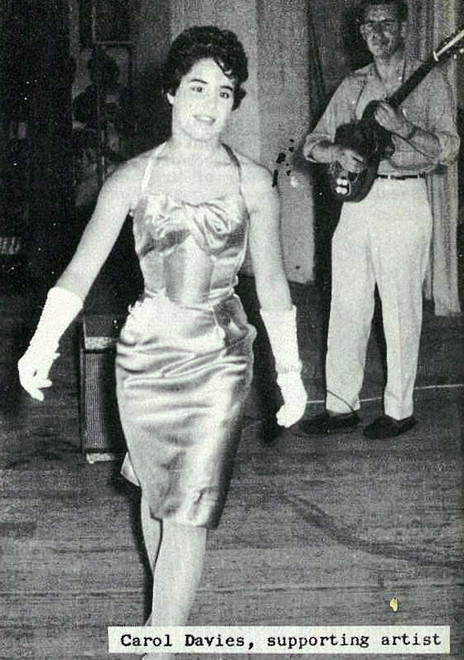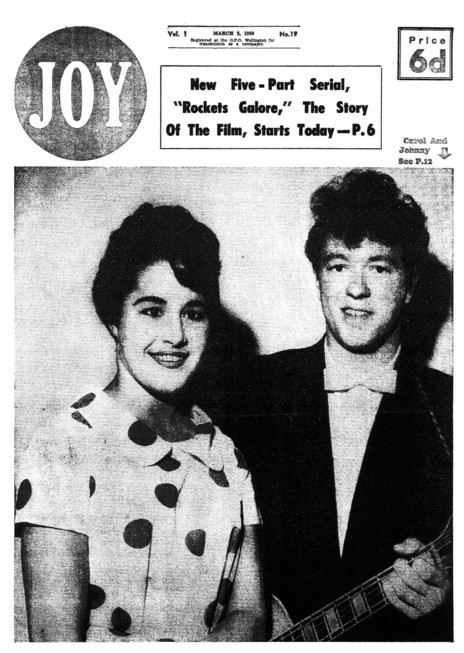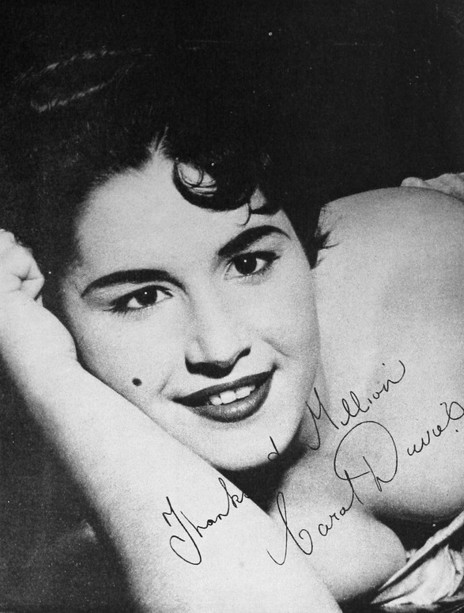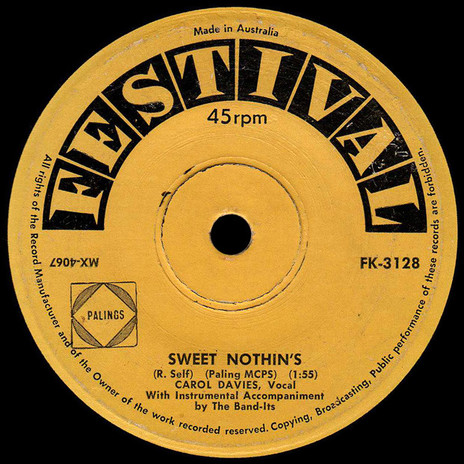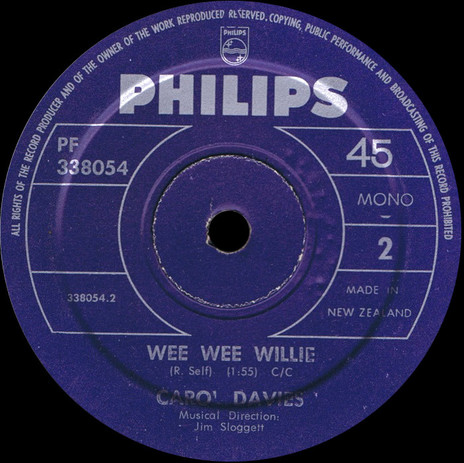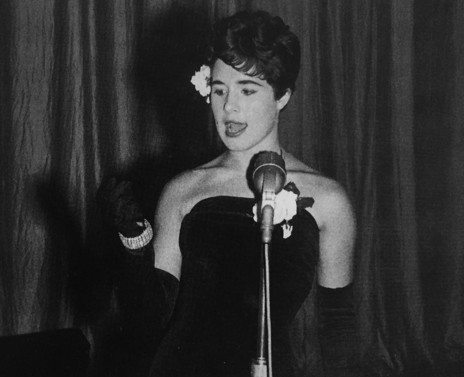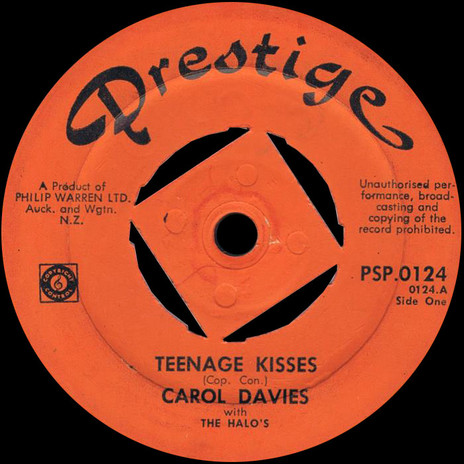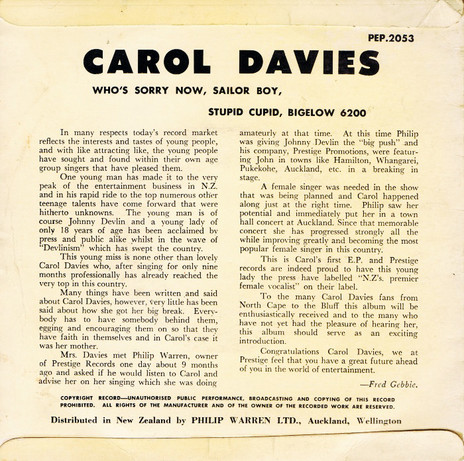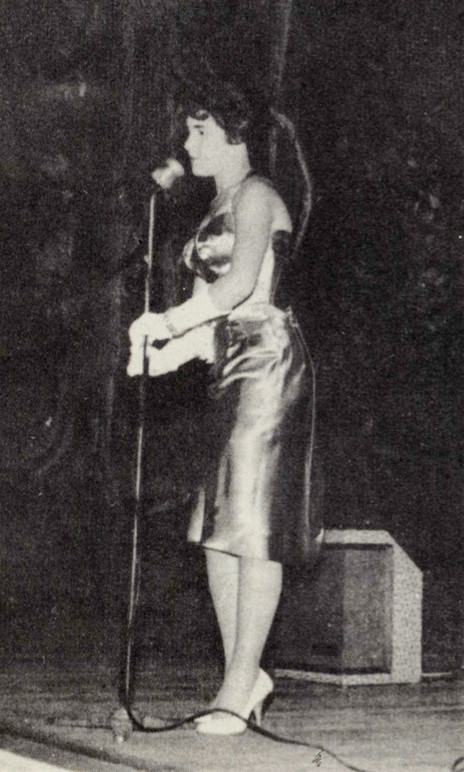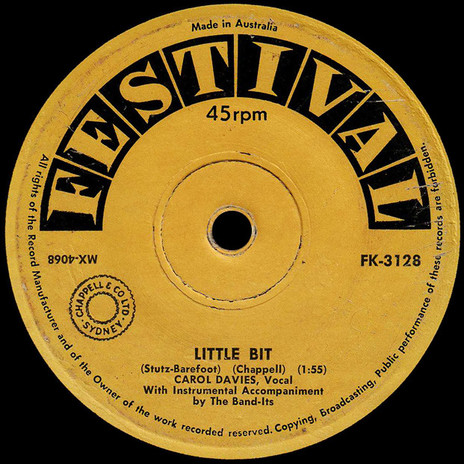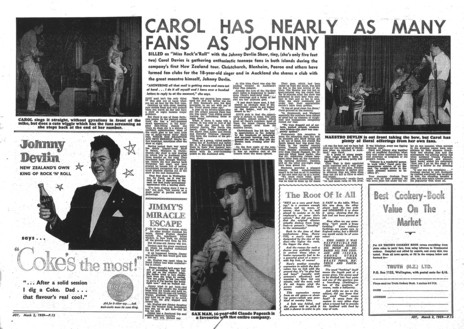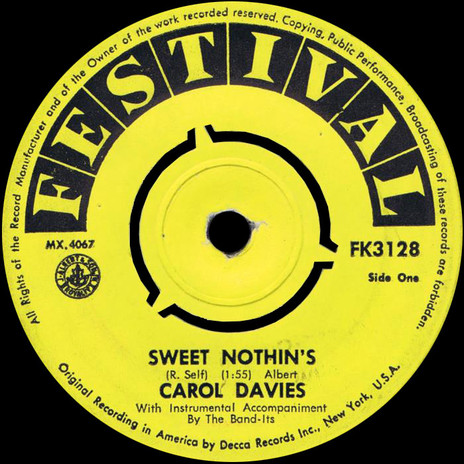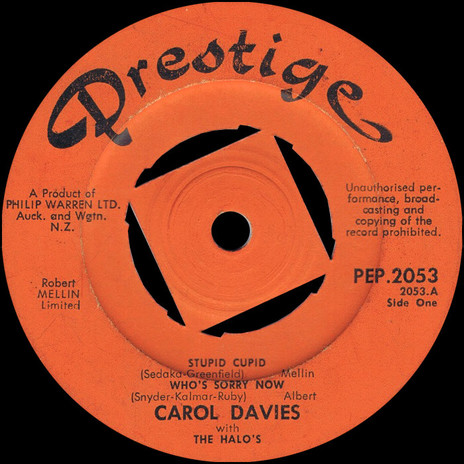Phil Warren, of Prestige Promotions, had been promoting Devlin in main North Island centres, and had an inkling what that thing was. And when a woman contacted him to talk about her 18 year-old daughter who sang, and he heard the girl’s impressive pipes, he recognised her potential and had his answer. It was an easy sell.
With Carol, Warren had the perfect, balanced set-up. He booked her on Devlin’s Auckland Town Hall concert and gave her a spot on the touring show’s programme billed as “New Zealand’s Connie Francis”. Along with several variety acts, including a magician, a female impersonator, a pair of comedians, and exhibition dancers, the whole shebang had a roof-raising 1958-59 countrywide tour with the nation’s own “Elvis”.
Aged 18 when she joined the Devlin show, Carol had been singing professionally for only nine months.
While Devlin was the headliner and Carol one of his supports, the press made the most of the opportunity to picture them together, playing up Devlin’s “Satin Satan” persona in counterpoint to Carol’s dark, beguiling looks. Canny reporters conjured plenty of column inches wherever the show toured, leaning on the good girl-bad boy polarity as typified 20 years later in Grease, where Olivia Newton-John’s wholesome Sandy falls for John Travolta’s worldly, leather-clad Danny.
Nothing ever happened between Carol and Devlin, but the press gave the intimation a good nudge in such publications as sixpenny weekly fanzine, Joy (published by the owners of New Zealand Truth), and the Gisborne Photo News. The pictures and stories kept stoking the star-maker machinery, to quote Joni Mitchell, and were alluring fish-hooks for smitten teens with pocket money.
When rock’n’roll arrived in New Zealand in the mid-50s, “It was just amazing, our lives changed overnight,” Carol recalled in the TVNZ series Give It a Whirl. “It felt as if I’d been plugged into a power socket. I thought I’d died and gone to heaven.”
Aged 18 when she joined the Devlin show, Carol had been singing professionally for only nine months. It was a big jump, but she adapted smoothly. And as a shining star of the moment – the original New Zealand pop-rock songbird – a follow-up record was a natural step. Her repertoire featured such Connie Francis covers as ‘Stupid Cupid’ and ‘Who’s Sorry Now’. Backed by the Halos she recorded both songs for her EP on Phil Warren’s Prestige label, along with ‘My Sailor Boy’ and ‘Bigelow 6200’.
The Devlin caravan journeyed across the Tasman at the beginning of the 1960s and continued its high-profile outings on stage and on television. Devlin’s equivalent there was the ebullient rocker, Johnny O’Keefe, who fronted his own TV shows, 6 O’Clock Rock and the Johnny O’Keefe Show. Like their US counterparts, these shows – along with Australia’s Bandstand and Sing, Sing, Sing! – showcased new singers, exhibition dancers and top live bands to a jiving, stand-up audience. It was the perfect setting for all upcoming and proven performers, and the New Zealand performers were from the top shelf across the Tasman.
Jimmie Sloggett was a standout musician and arranger on the Australian music shows, including Bandstand and Johnny O’Keefe’s two. He was a young saxophonist and arranger, who later became renowned as a bandleader, studio owner, record producer and musical director. Carol and Jimmie met when she was performing on the shows and some three years on they were married.
“Carol came over with Johnny Devlin and she was hailed as New Zealand’s Miss Connie Francis at the time,” Sloggett told Chris Bourke in 2006. “She had a beautiful voice and she had great records, and we met on Bandstand. As a matter of fact, our engagement was made public on Bandstand. I wasn’t quite up to that at the time – I dunno, maybe a bit too conservative – and I simply wanted to have a look at her country. It’s really that simple.
“Johnny O’Keefe tried to talk me out of going anywhere. He said, ‘Because you’ve just started arranging for us. You’ve done my two records, you’ve done this … why do you wanna go away?’”
Despite O’Keefe’s exhortations, Mr and Mrs Sloggett left Australia for New Zealand in 1963, for Jimmie’s “look around” and Carol’s return home. A retrospective on ABC Radio recalled in 2015: “Jimmie had enjoyed Carole’s [sic] stories of her homeland so much that he decided to visit and see the place for himself. He fell in love with what he found and ended up calling it home for more than a decade away.”
Jimmie and his saxophone made an immediate impact in New Zealand. In short order he was playing with top New Zealand acts, touring with them and overseas artists, producing singles, acting as musical arranger, making jingles, recording and playing jazz. Saxophone was a key frontline instrument at that time in pop and rock music, and horns also provided a good visual element in band lineups behind the singers or dancers on the new music shows which were all in black and white back then.
Carol, who was on top of her game after Devlin’s Australian tour, was in demand once back in New Zealand and sang on the most famous local TV pop show, C’mon (1967-69), fronted by Pete Sinclair. While Carol was on centre stage, Jimmie, as musical director, and his sax were right there behind her.
C'mon was the pop music highlight of the week alongside such regulars as Lassie, I Love Lucy, The Flintstones, and Mister Ed. And among all those watching there were none so attentive on Saturday nights at 7pm as a small audience of three plus one: Carol and Jimmie’s three children – Leesa, Kristy and Matthew – and their grandmother.
“We were very young back then, my brother and my sister and me,” daughter Leesa says, from Sydney, “and I remember sitting at my grandmother’s house, dressed in our pyjamas, waiting for Carol to appear on TV. We were very proud of her. She can still sing. She’s still got a great voice, but she’s sort of shy. She is nudging 80.”
By the mid-1970s Jimmie was a kingpin of the Auckland music scene, arranging, producing and performing. But home was calling and in 1977 the Sloggetts moved back to Sydney. While Jimmie resumed his musical career, building his Cremorne studio, creating jingles for Mojo ad agency, MDing and so on, Carol gave up her singing career to concentrate on family life.
“She was a beautiful mum,” Leesa says. “Her life revolved around us. She made every birthday and Christmas very special.”
Son Matthew became a musician and worked with Jimmie, writing and producing countless soundtracks and jingles, among them the Meadow Lea margarine jingle, ‘You Oughta Be Congratulated’, and the World Series Cricket theme, ‘C’mon Aussie C’mon’.
Carol Davies had the tonsils, the looks, the range and the sass.
The marriage ended some 20 years ago. Carol lives in Sydney and Jimmie, who continued working until relatively recently, is based in Melbourne.
Carol Davies had the tonsils, the looks, the range and the sass. She could belt it out with the best of them or sing a smooth, tender ballad. Over the course of her short career, she recorded around a dozen songs, among them ‘Sweet Nothin’s’ [sic], a raunchy cover of a Brenda Lee hit single. In recent years she and her songs continue to feature on international compilations of early New Zealand rock ’n’ roll.
There are a few YouTube clips of Carol singing songs such as ‘Wee Wee Willie’, ‘Stupid Cupid’, ‘Sweet Nothin’s’, and ‘Bony Moronie’ with a static image, such as a record cover. It is disappointing, considering her status as this country’s first acclaimed rock’n’roll singer and her undoubted singing ability, that she is not more widely known and that no film clips of her regular television appearances seem to exist.
“Let’s hope Carol [realises] how much she meant to New Zealand history,” Leesa says. “I want her to be proud of what she did. She is so self-effacing.”
--
Read more: Carol Has as Many Fans as Johnny (Joy, 1959)
